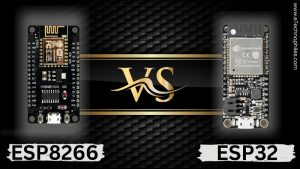Last updated on June 8th, 2023 at 04:45 pm
Espressif Systems is known for its popular microcontrollers, ESP32 and ESP8266. Although both microcontrollers offer Wi-Fi connectivity, the ESP32 stands out with its dual-core processor, built-in temperature and hall sensor, larger RAM, flash memory, and additional features such as Bluetooth and Ethernet support. On the other hand, the ESP8266 is a more affordable option for simple projects.
Which one to choose? ESP32 vs ESP8266
Given below are the important factors to consider before deciding:
- ESP32 is more powerful and has more GPIO pins
- ESP32 is the updated version of ESP8266
- ESP8266 doesn’t have Bluetooth support
- ESP32 has built-in temperature and hall effect sensor
- ESP32 consumes less power in its lowest settings
- All new development boards by Espresiff are based on ESP32
- ESP8266 has a very low price, almost half of ESP32.
Note: In 2014, Espressif released ESP8266. Later in 2016, they launched its advanced version known as ESP32.
Table of Contents
NOTE A: Comparison between ESP32 and ESP8266 usually means comparing their breakout boards and not ICs/microcontrollers. We are also comparing their breakout boards in this article.
ESP32 VS ESP8266- Specifications
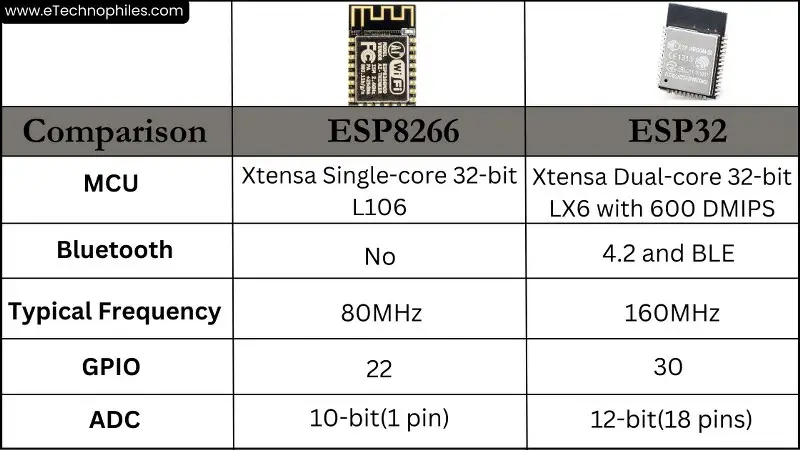
The following table gives a detailed comparison between ESP32 and Esp8266:
| Comparison | Esp8266 | ESP32 |
| MCU | Xtensa Single-core 32-bit L106 | Xtensa Dual-Core 32-bit LX6 with 600 DMIPS |
| 802.11 b/g/n Wi-Fi | HT20 | HT40 |
| Bluetooth | NO | Bluetooth 4.2 and BLE |
| Typical Frequency | 80 MHz | 160 MHz |
| SRAM | NO | YES |
| GPIO | 22 | 30 |
| Hardware /Software PWM | None / 8 channels | None / 8 channels |
| SPI/I2C/I2S/UART | 2/1/2/2 | 4/2/2/2 |
| ADC | 10-bit x 1 channel | 12-bit x 18 channel |
| DAC | NO | 8-bit x 2 channel |
| CAN | NO | YES |
| Ethernet MAC Interface | NO | YES |
| Touch Sensor | NO | YES |
| Power Consumption | 20uA | 10uA deep sensor |
| Security | NO | Security Boot flash encryption. OTP 1024-bit |
| Temperature Sensor | NO | YES |
| Hall effect sensor | NO | YES |
| Working Temperature | -40ºC to 125ºC | -40ºC to 125ºC |
| Price | (3$ – $6) | ($6 – $12) |
NOTE: Using ESP32 or ESP8266 breakout boards is not easy. Only when developing an industrial or commercial product using a breakout board makes sense. For everyday projects or prototyping, development boards based on these chips are recommended. These are also easier to program using programming environments such as Arduino IDE.
Which one is more powerful- ESP32 or ESP8266?
ESP32 is more powerful than ESP8266 in terms of processor, speed, memory, and number of GPIO pins.
CPU and Cores
ESP8266 has a single-core 32-bit Tensilica microcontroller with a maximum clock speed of 80 MHz. ESP32 has a dual-core 32-bit Xtensa LX6 microprocessor, clocked at up to 240 MHz. Single core limits the multitasking capabilities of ESP8266.
Speed
Due to higher clock speed, ESP32 performs tasks faster than ESP8266.
GPIO pins
ESP32 has 38 pins, out of which 30 pins are GPIOs, and ESP8266 has 22 pins, out of which 17 are GPIOs.
If we compare the multiple functions of GPIO pins on ESP32 vs esp8266:
- ESP32 has 18 analog-enabled pins(12-bit resolution), whereas ESP8266 has only 1 Analog input pin (10-bit).
- ESP32 supports 8-bit DAC(digital to analog converter) on two pins. ESP8266 has zero.
- ESP32 has ten capacitive touch pins that can be used as touch sensors.
So clearly, ESP32 is the winner in this category as well.
You may have noticed that ESP8266 is sometimes referred to as Nodemcu. But why? NodeMCU is an open-source firmware initially developed for the ESP8266 module. The term “NodeMCU” was coined to market the ESP8266 module, and soon “NodeMcu” started to be associated more with the hardware than the firmware. Nowadays, ESP32 is also referred to as NodeMCU sometimes.
ESP32 has Bluetooth support
Unlike the ESP8266, the ESP32 chip includes both Wi-Fi and Bluetooth connectivity options. Using this you can interact with a wide range of Bluetooth-enabled devices, such as smartphones, tablets, Bluetooth speakers, wearable devices, and more.
The Bluetooth module on ESP32 features Bluetooth Low Energy (BLE) protocol, which is ideal for low-power and battery-operated devices.
Power consumption- ESP32 VS ESP8266
The power consumption between these two boards depends on the mode of operation and network conditions:
In active mode, ESP32 consumes around 150mA – 240mA, whereas Esp8266 consumes 70mA to 80mA.
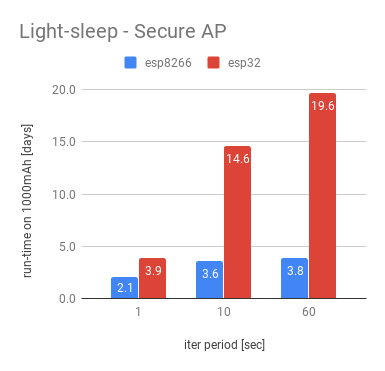
The ESP8266 consumes less power in deep-sleep mode with periodic wake-up when using an open access point. However, when using a secure access point or in light-sleep mode maintaining an association, the ESP32 performs better in terms of power consumption. Additionally, the ESP32’s larger memory makes it more practical for secure connections using TLS.
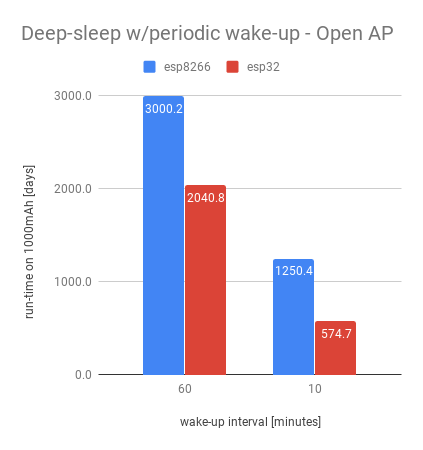
For most of the battery-powered applications, light-sleep mode is used. Hence, ESP32 is the best option in this case.
[Read more here…]ESP32 VS ESP8266: Which is easier to program?
Development boards based on ESP32 and ESP8266 supports both Arduino IDE and Micropython. Since ESP32 is new and more popular, the libraries(Arduino IDE) are constantly updated for it. ESP32-based development boards are also the first to get support for new modules/devices.
Programming with Arduino Ide
Both ESP32 and ESP8266 can be programmed using the same Arduino IDE framework. They have similar programming syntax, and you can use the Arduino libraries and ecosystem for both platforms. However, note that some specific features or libraries may be unique to each board.
Adding ESP32/ESP8266 Board Support: To program the ESP32 or ESP8266, you need to add the respective board support to the Arduino IDE. Go to “File” -> “Preferences” in the Arduino IDE and enter the following URL in the “Additional Boards Manager URLs” field:
For ESP8266: http://arduino.esp8266.com/stable/package_esp8266com_index.json
For ESP32: https://dl.espressif.com/dl/package_esp32_index.json
Click “OK” to save the preferences. Then, go to “Tools” -> “Board” -> “Boards Manager.” Search for “ESP8266” or “ESP32” in the Boards Manager, select the appropriate package, and click “Install.”
ESP8266 costs less
The price of the ESP8266 breakout board is almost half of the ESP32. You can get ESP32 for $6 – $12 and an ESP8266 for $3- $6.
Although, there is not a huge difference in price for development boards.
ESP32 VS ESP8266- How to decide?
To decide which one will be a good choice for your applications and projects, you can follow the thought process as shown below using a flowchart. [Read more here..]
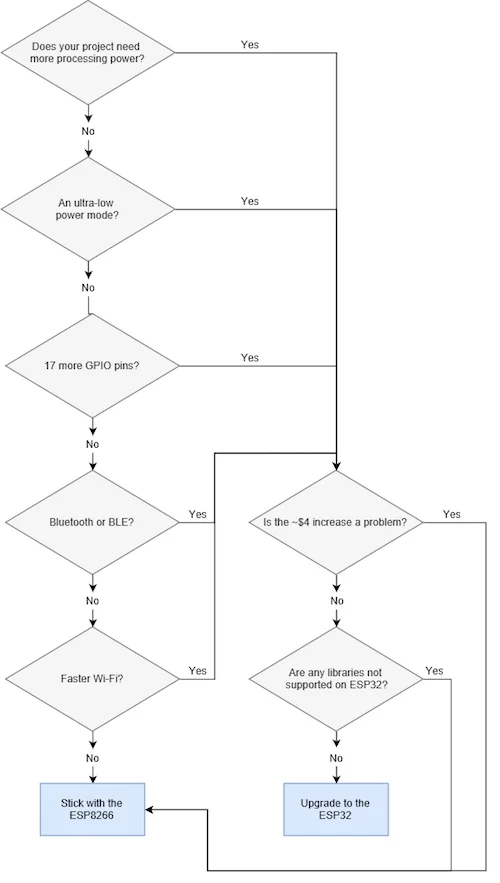
ESP32 VS ESP8266: Which is Better?
ESP32 is a newer and upgraded version of Esp8266. It also has lots of new features which are absent in Esp8266. But the price of ESP32 is a little higher than Esp8266. In the end, ESP32 offers more processing power and newer support, so it is worth going for the new and latest ESP32 than taking the underperforming Esp8266.
